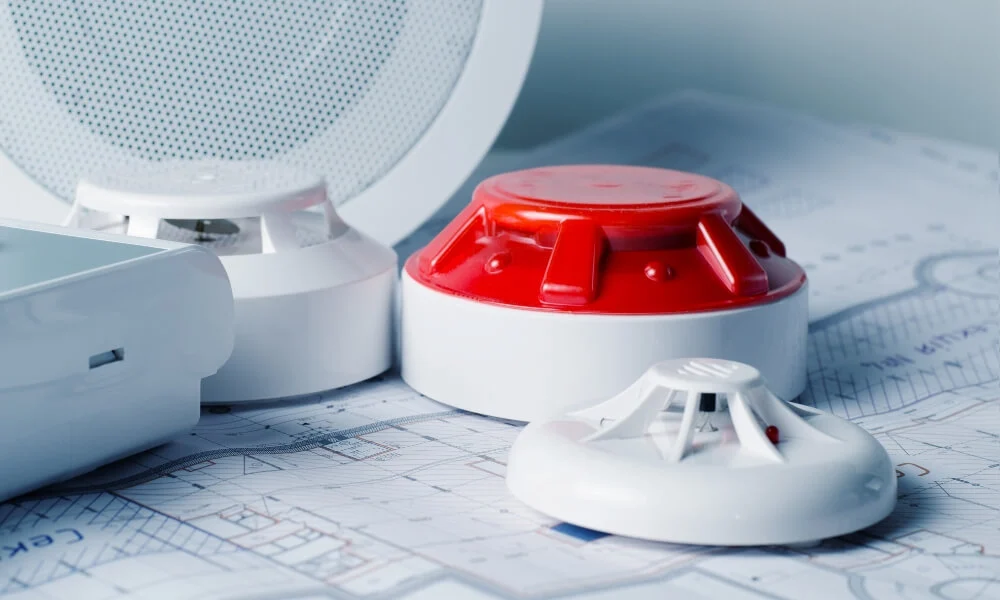Fire detectors are critical safety devices designed to detect the presence of fire, smoke, or heat, providing early warnings that can save lives and minimise property damage. Their importance cannot be overstated, as they are often the first line of defense in preventing fire-related tragedies. Understanding the various types of fire detectors and their working mechanisms is crucial for ensuring optimal safety in homes, offices, and public buildings.
Types of Fire Detectors
- Smoke Detectors: These are the most common type of fire detectors and come in two main varieties:
- Ionization Smoke Detectors: These detectors are particularly effective at sensing flaming fires. They contain a small amount of radioactive material between two electrically charged plates, which ionizes the air and creates a current. When smoke enters the chamber, it disrupts this ionization process, reducing the current and triggering the alarm.
- Photoelectric Smoke Detectors: These detectors are more responsive to smoldering fires. They use a light source and a light sensor placed at an angle within a sensing chamber. Smoke entering the chamber scatters the light, which then hits the sensor and activates the alarm.
- Heat Detectors: These devices are triggered by a rapid increase in temperature or when a fixed temperature is reached. They are less sensitive than smoke detectors and are typically used in environments where smoke detectors may cause false alarms, such as kitchens or garages. Heat detectors come in two main types:
- Fixed Temperature Heat Detectors: These activate the alarm when the temperature exceeds a predetermined threshold.
- Rate-of-Rise Heat Detectors: These trigger the alarm if the temperature rises rapidly over a short period, even if the fixed temperature threshold is not reached.
- Carbon Monoxide Detectors: While not fire detectors in the traditional sense, carbon monoxide (CO) detectors are essential in detecting the presence of CO gas, which can be a byproduct of incomplete combustion in fires. CO detectors use electrochemical sensors to detect dangerous levels of carbon monoxide in the air, prompting an alarm.
- Flame Detectors: These detectors sense the presence of flames through the infrared, ultraviolet, or visible light emitted by the fire. Flame detectors are often used in high-risk areas such as industrial settings where highly combustible materials are present. They offer a fast response to fires but are typically more expensive and complex to install.
How Do Fire Detectors Work?
The operation of fire detectors hinges on their ability to sense changes in the environment that indicate the presence of fire. Here’s a closer look at how the different types work:
- Ionization Smoke Detectors: These work by ionizing the air in the detection chamber. The ionization process creates a small current, which is disrupted when smoke particles enter, causing the alarm to sound.
- Photoelectric Smoke Detectors: These operate using a light beam directed away from a sensor. When smoke enters the chamber, it scatters the light towards the sensor, which then triggers the alarm.
- Heat Detectors: They function either by measuring the ambient temperature and sounding an alarm when a certain threshold is exceeded (fixed temperature) or by detecting a rapid rise in temperature (rate-of-rise).
- Carbon Monoxide Detectors: These use electrochemical sensors to detect CO gas. The sensor reacts with carbon monoxide, generating an electrical current that activates the alarm.
- Flame Detectors: They use sensors to detect specific wavelengths of light emitted by flames. When the sensors detect these wavelengths, the alarm is triggered.
Conclusion
Fire detectors are indispensable for ensuring safety and mitigating the risks associated with fires. By understanding the different types of fire detectors and their operation mechanisms, individuals and organizations can make informed decisions about the best fire detection systems for their specific needs. Regular maintenance and testing of these detectors are crucial to ensure they function correctly when needed most.



